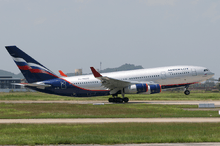Rotation (aeronautics)
In aviation, rotation refers to the action of applying back pressure to a control device, such as a yoke, side-stick or centre stick, to lift the nose wheel off the ground during takeoff. Rotation at the correct speed, known as VR, and to the correct angle is important for safety reasons and to decrease takeoff distance.[1] After rotation the aircraft continues to accelerate until it reaches its liftoff speed VLO at which point it leaves the runway. Over-rotation can cause a tailstrike in which case damage to the underside of the tail is prevented by a tail bumper. A certification test is required to show that a new aircraft design will still take off safely with the tail dragging on the runway.
Description
Rotation applies to tricycle gear aircraft rather than those with conventional gear. The on-ground angle of attack of the wing has to be established during the design phase. The main and nose-gear leg lengths are chosen to give a negative angle of attack relative to the ground. This ensures the wing will have negative lift until the pilot rotates the aircraft to a positive angle of attack. During landing the reverse happens when the nose-wheel touches the runway and the wing assumes a negative angle of attack with no lift. At one time Cessna Aircraft featured this idea as "Land O Matic," so noted on all of their tricycle-gear aircraft.
References
- Christopher L. Parker. "Normal Takeoff and Climb". AOPA. Retrieved 10 July 2010.
